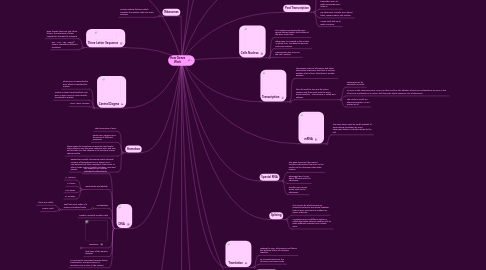
1. RNA
1.1. Perform chemical reactions in our bodies
1.2. Consist of nucleotides that have been formed together
1.3. Single Stranded
1.4. Is Transcribed from DNA
1.5. temporary mediator between DNA the ribosomes
1.6. much shorter than DNA or the average protein
1.7. carries information from the genome to the ribosomes
2. DNA
2.1. The sequence of a gene’s individual building blocks
2.2. Nucleotides are labeled:
2.2.1. A: Adenine
2.2.2. T: Thyme
2.2.3. C:Cytosine
2.2.4. G: Guanine
2.3. Nucleotides
2.3.1. Spell out exact order of a protein's building blocks
2.3.1.1. These are called:
2.3.1.2. Amino Acids
2.4. Double Stranded: Double Helix
2.5. Mutations
2.5.1. A kind of typographical error in a gene’s DNA sequence
2.5.2. Can be:
2.5.2.1. A Change
2.5.2.2. A Gap
2.5.2.3. A Duplication
2.5.3. Can cause a gene to encode a protein that works incorrectly or not at all
2.5.4. Not all DNA changes are harmful
2.5.4.1. Some have no effect
2.5.4.2. some produce new versions of proteins that give a survival advantage
2.5.4.3. Helps evolution persue
2.6. hard-copy of the genetic material
2.7. it is extremely important because during transcription, one gene (DNA) is rewritten into an RNA in the nucleus
3. Research
3.1. Until recently, researchers looked at genes, and the proteins they encode, one at a time.
3.2. Now, they can look at how large numbers of genes and proteins act, as well as how they interact.
3.3. scientists can identify all of the genes that are transcribed in a cell
3.4. Researchers may be able to learn how to stop or jump-start genes on demand, change the course of a disease or prevent it from ever happening.
4. Homebox
4.1. short sequence of DNA
4.2. similar DNA sequences in the genes of different organisms
4.3. these genes do something so important and useful that evolution uses the same sequence over and over and permits very few changes in its structure as new species evolve.
4.4. Researchers quickly discovered nearly identical versions of homeobox DNA in almost every non-bacterial cell they examined—from yeast to plants, frogs, worms, beetles, chickens, mice and people.
5. Central Dogma
5.1. when DNA is transcribed to RNA which is translated to protein
5.2. Protein is never translated back into RNA or DNA; DNA is never directly translated to protein
5.3. DNA RNA protein
6. Three Letter Sequence
6.1. Even though there are only three letters, the sequence of them completely changes the meaning
6.2. RAT - TAR - ART - same 3 letters; completely different meanings.
7. tRNA
7.1. Transfer RNA
7.2. important because it carries a specific amino acid at one end and recognizes and binds mRNA at the other end
7.3. The tRNA that binds to that mRNA codon determines what amino acid will be added to a protein
8. Ribosomes
8.1. protein making factories which translate the genetic code into more proteins
9. Initiation and Stop Codons
9.1. All proteins start with the initiation codon
9.2. AUG All proteins end with stop codons -either UAA, UGA, or UAG.
10. Genes
10.1. Carry out traits through generations
10.2. Made of deoxyribonucleic acid
10.3. Don't carry out actual work
10.4. Service as instruction books for making functional molecules
10.4.1. RNA
10.4.2. Proteins
11. Protein
11.1. Provide body's main building materials
11.2. the physical outcome of the information contained within the genome
11.3. vary greatly in their activity and they come in all shapes and sizes
11.4. Can't copy themselves
11.5. Uses instructions to copy itself coded in the DNA
11.6. Form Cells:
11.6.1. Architecture
11.6.2. Structural Components
12. Chromosomes
12.1. Long strings of nucleotides of formed genes
12.2. Every cell contains chromosomes in its nucleus EXCEPT
12.2.1. Eggs
12.2.2. Sperm
12.2.3. Blood Cells
12.3. If the cells were uncoiled, it would be 6 feet long
12.4. If all DNA in your body were connected it would stretch 67 billion miles
12.5. Humans have 23 pairs
12.5.1. Women possess of X &X
12.5.2. Men possess X & Y
13. Diploid and Haploid Cells
13.1. Most of our cells are diploid
13.1.1. they have two sets of chromosomes
13.1.1.1. 23 pairs
13.2. Eggs and sperm are haploid cells
13.2.1. Each haploid cell has only one set of 23 chromosomes so that at fertilization the math will work out
13.2.1.1. A haploid egg cell will combine with a haploid sperm cell to form a diploid cell
14. Post Transcription
14.1. First step in making a protein
14.2. RNA polymerase transcribes DNA to make messenger RNA (mRNA).
14.3. On ribosomes, transfer RNA (tRNA) helps convert mRNA into protein
14.4. Amino acids link up to make a protein.
15. Special RNA
15.1. The gene transcript (the mRNA) transfers information from DNA in the nucleus to the ribosomes that make protein.
15.2. Ribosomal RNA forms about 60 percent of the ribosomes.
15.3. transfer RNA carries amino acids to the ribosomes.
16. Transcription
16.1. the genetic material of humans and other eukaryotes (organisms that have a nucleus) includes a lot of DNA that doesn't encode proteins.
16.2. the cell needs to trim out the intron sections and then stitch only the exon pieces together . This process is called RNA splicing.
16.2.1. Splicing has to be extremely accurate.
16.2.2. An error in the splicing process, even one that results in the deletion of just one nucleotide in an exon or the of just one nucleotide in an intron, will throw the whole sequence out of alignment.
16.2.3. The result is usually an abnormal protein—or no protein at all.
